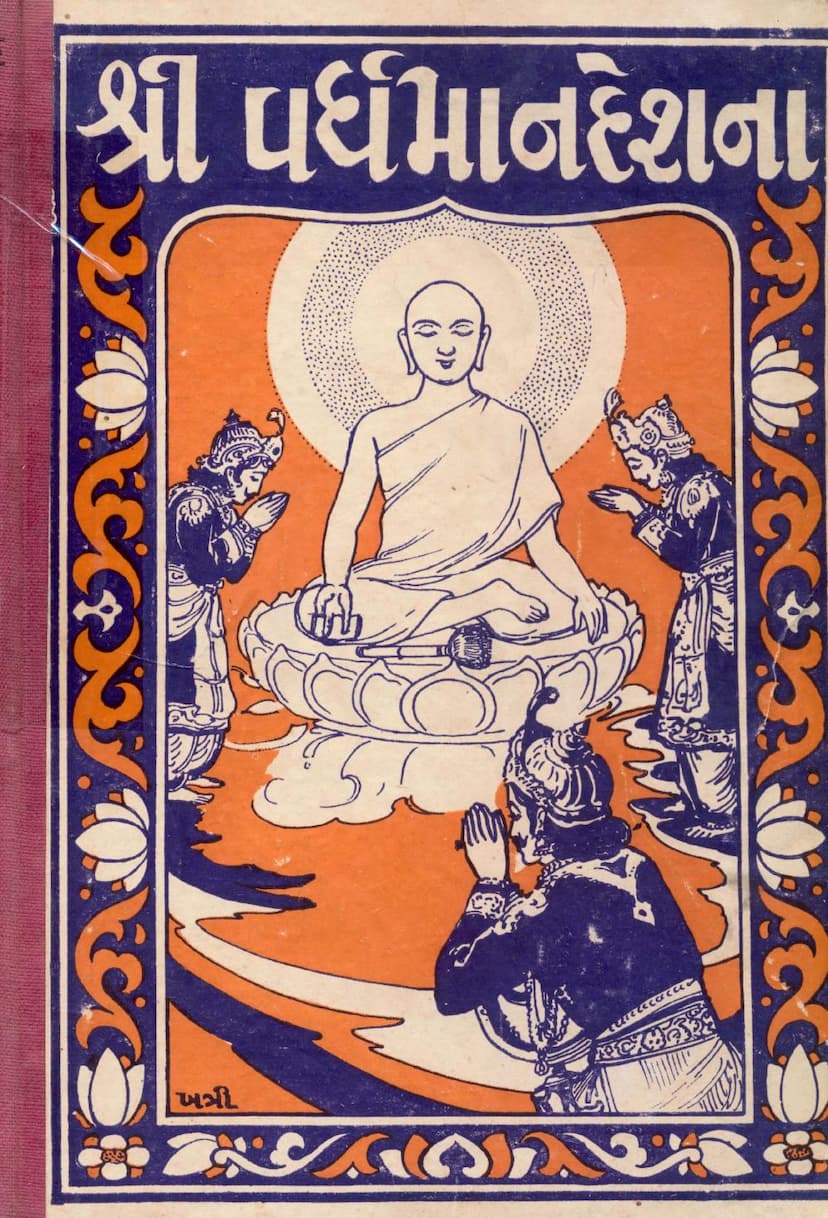Vardhaman Deshna
Added to library: September 2, 2025

Summary
Here's a comprehensive summary of the Jain text "Vardhaman Deshna" based on the provided pages:
Book Title: Vardhaman Deshna (वर्धमान देशना) Author: Rajkirti Gani (રાજકીર્તિ ગણિ) Translator: Muni Vishalvijay (મુનિ વિશાલવિજય) Publisher: Jaswantlal Girdharlal Shah (જસવંતલાલ ગીરધરલાલ શાહ) Publication Year: 1955 AD (V.S. 2011 / V.S. 2481) Origin of Text: The book is a translation of a work originally in Sanskrit and Magadhi.
Core Theme: "Vardhaman Deshna" is a collection of sermons (deshna) delivered by Bhagwan Mahavir Swami, the 24th Tirthankar. These sermons, particularly those given to the ten prominent lay disciples (shravakas) like Anand and Kamdev, are expounded in detail by the fifth Ganadhara, Shri Sudharmaswami, for the benefit of the final Kevalin, Shri Jambu Swami. The text focuses on the virtues, spiritual achievements, devotion, unwavering faith, and the obstacles faced by these exemplary lay followers, including the disturbances caused by deluded deities. It aims to provide moral guidance and inspire readers to follow the path of righteousness and non-violence as taught by Lord Mahavir.
Key Elements and Stories:
The book is structured around the lives and exemplary conduct of ten prominent lay disciples (shravakas) and includes various illustrative narratives:
- Anand Shravak: His character, faith, and adherence to principles are highlighted.
- The Ten Shravakas: The text delves into the lives of these ten householders, emphasizing their wealth, virtuous actions, devotion, pure faith, and how they exemplified Jain principles even amidst worldly prosperity. Their lives serve as a model for aspiring lay followers.
- The Twelve Vows (Shrāvak Vrat): The book details the significance and practice of the twelve vows undertaken by lay disciples:
- Five Minor Vows (Anu-vrats):
- Non-violence (Pranaatipata Viraman Vrat) - illustrated by the story of Haribal the fisherman.
- Truthfulness (Mrushavada Viraman Vrat) - illustrated by the story of Hansraja.
- Non-stealing (Adattadana Viraman Vrat) - illustrated by the story of Lakshmipunj.
- Celibacy/Chastity (Maithuna Viraman Vrat) - illustrated by the story of Madiravati.
- Non-possession (Parigraha Parimana Vrat) - illustrated by the story of Dhansar.
- Six Specific Vows (Shiksha Vrat):
- Night-eating prohibition (Ratri Bhojana Viraman Vrat) - illustrated by the story of Keshav and Hans.
- Sense-control (Dig-parimana Vrat) - illustrated by the story of Charudatta.
- Enjoyment-control (Bhoga-upbhoga Viraman Vrat) - illustrated by the story of Dharmakumar.
- Non-sinful activities (Anarthadanda Viraman Vrat) - illustrated by the story of Surasen and Mahasen.
- Samayika (Meditation/Equanimity) - illustrated by the story of Kesari the thief.
- Deshavkashik (Limited movement/living in a specific region) - illustrated by the story of Sumitra the minister.
- Eleven Auspicious Observances (Ekādasha Pratima): These are advanced practices for householders progressing spiritually.
- Five Minor Vows (Anu-vrats):
- Illustrative Stories (Kathas): The book is rich with narratives that exemplify each vow and principle. These stories often feature kings, merchants, noblemen, virtuous women, and even supernatural beings, illustrating the consequences of adhering to or deviating from Jain ethics. Examples include:
- Aramshobha: A story highlighting the virtue of chastity (Samkit) and its positive outcomes.
- Haribal the Fisherman: Teaches the importance of adherence to vows, even in difficult circumstances, and the rewards of compassion.
- Nandan: A story about integrity and overcoming greed.
- Madiravati: Exemplifies chastity and its power.
- Dansar (Lakshmipunj): Demonstrates the detrimental effects of miserliness and the importance of righteous charity, contrasting with the benefits of renunciation.
- Bhimakumar: Shows the power of compassion and its divine rewards.
- Surasen and Mahasen: Illustrates the consequence of negative speech and the importance of righteous conduct.
- Charudatta: Highlights the difficulties arising from attachment and the eventual spiritual upliftment through virtue.
- Kesari the Thief: A powerful narrative on the transformative power of sincere repentance and the practice of Samayika, even for a notorious criminal.
- Sumitra the Minister: Demonstrates the virtues of integrity and righteous governance.
- Ranashar: Illustrates the unwavering commitment to truth and vows, even when facing severe trials.
- Dharmakumar: Shows how adherence to virtuous vows can overcome worldly afflictions and bring about prosperity.
- Kandalika: A story about the strength of faith and the protection offered by righteous principles.
- Mahashatak: A merchant whose greed and negative actions lead to immense suffering, contrasted with the blessings of dharma.
- Nandinipriya: An example of devotion and righteous conduct leading to divine favor.
- Tetliputra: Illustrates the importance of knowledge and the rejection of false philosophies.
Overall Message: The "Vardhaman Deshna" aims to instill a deep understanding and appreciation for the Jain path of liberation. It emphasizes that true happiness and spiritual advancement are achieved through righteous conduct, unwavering faith in the Tirthankaras, the teachings of the gurus, and adherence to the dharma, especially the principles of non-violence, truthfulness, and detachment. The stories serve as practical lessons, showing that even worldly prosperity and divine favor are blessings that stem from virtuous actions and adherence to the vows.
Key Takeaway: The text encourages readers to reflect on their own lives and strive to integrate the virtuous qualities and practices of the shravakas and shravikas mentioned, ultimately guiding them towards the path of salvation. It highlights that the teachings of Lord Mahavir, even after 2500 years, remain relevant and powerful in guiding humanity towards spiritual liberation.